They work from sunrise to sunset, risk their lives and those of their family's. Here are the women and men checking the spread of a highly infectious Coronavirus on their feet
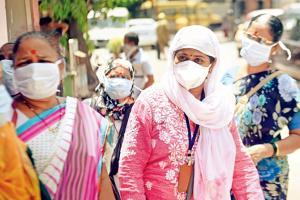
Meghana Dolkar, a community health volunteer with B Ward, works as a contact tracer with the BMC
Meghana Dolkar's life isn't the one she recognises. The 35-year-old community health volunteer (CHV) with B ward who kept a 9 am to 2 pm shift, going about the city's lesser privileged neighbourhoods, is suddenly a 24/7 firefighter. Dolkar is part of the Brihanmumbai Municipal Corporation's (BMC) contact tracing team.
In March, when the civic body drew up a list of health workers who would join the programme that would help track down people who had come in contact with COVID-19 positive patients, Dolkar was happy to see her name featured. "I was an anomaly," she laughs. "Of course, it wasn't a welcoming prospect to come in close contact with people, who have been exposed to a dangerous and easily transmissible virus, but it is a job and somebody has to do it." For the last 10 years, Dolkar has made the rounds of Bhendi Bazaar, Umerkhadi and Dongri, going door-to-door to provide guidance on polio, leprosy, tuberculosis and childcare. The questions are often scripted: "Have your children been vaccinated?", "Do you need information on family planning?", "Has the pregnant woman in the house had a checkup?"
ADVERTISEMENT
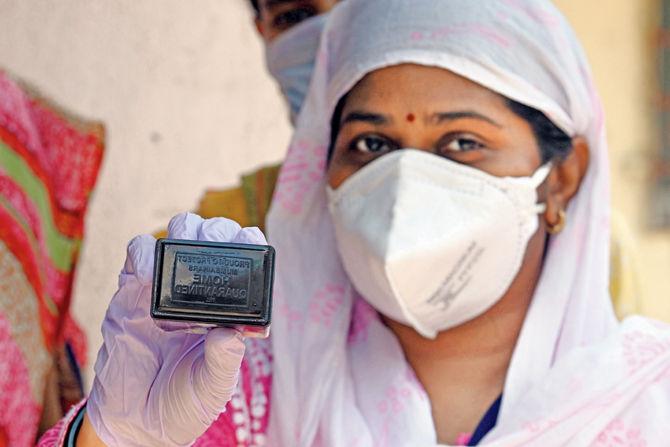
Meghana Dolkar, community health volunteer, visits a household in Dongri
Dolkar now works seven days a week. She can no longer shoot the questions as if on autopilot; she must employ stealth and tact. "These days, I barely get to see my husband and five-year-old daughter," she tells us over a phone call.
It's past sundown and we have 20 minutes to wrap up the conversation before she can head back to the municipal office in Noor Baug. Fortunately, her home is at a short distance from work, which also means she's one of the first to be called in when a fresh case is reported. "There is no concept of night and day. If a positive case is reported, we have to act immediately, because contacts can add up fast. Only early diagnosis and treatment will help blunt the severity of the virus."
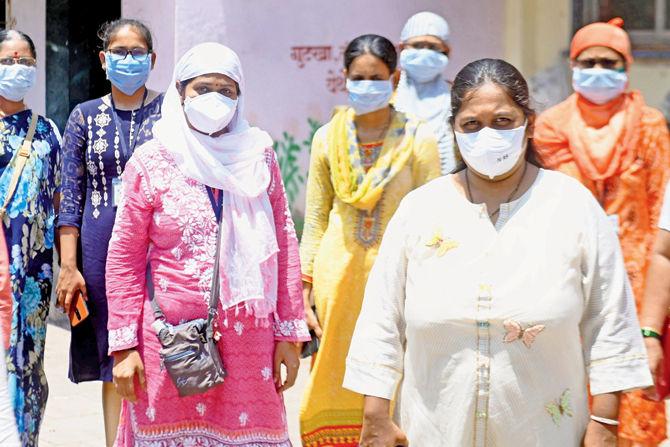
Dr Siddhi Koli and her team of public health officials, who are responsible for contact tracing
As countries across the world weigh the possibility of reopening after months of lockdown in the face of the Coronavirus pandemic, the demand for contact tracing has come into sharp focus. The World Health Organisation (WHO) defines it as the process of identifying people in close contact with someone who is infected with a virus, as they are at a higher risk of becoming infected themselves, and of potentially infecting others. It further states that closely watching them after exposure will prevent the transmission of the virus.
Last week, the BMC municipal commissioner IS Chahal instructed that for every COVID-19 patient, BMC's contact-tracers must identify at least 10 high-risk and low-risk contacts. High-risk contacts typically include family members, caregivers and anyone who came in contact with the patient for six hours or more, whereas the latter are those who share the same physical space with the infected person. Chahal's order came after his visit to M East ward (Govandi, Mankhurd), a COVID-19 hotspot. Mumbai has over 27,200 COVID-19 cases, and the current death toll stands at 909. At 44,582 Maharashtra leads in terms of the number of active cases, according to the health ministry. Currently, Mumbai has 24 teams on the ground to carry out the task of contact tracing. "The exercise starts in the hospital when a patient tests positive. The healthcare staff collects as many details as possible from the patient and passes on the information to the field teams. Our health staff then swings into action to locate contacts and regularly follows up with each of them for symptoms of the infection," says Dr Bhupendra Patil, medical officer of health, M West ward (Chembur and Deonar). While the number of high-risk contacts vary from case to case, officials said Mumbai is currently tracing an average of 30 contacts per infected person. The teams consist of assistant medical officers (AMO), peripheral health nurses (PHN), auxiliary nurses, medical coordinators and community health volunteers.
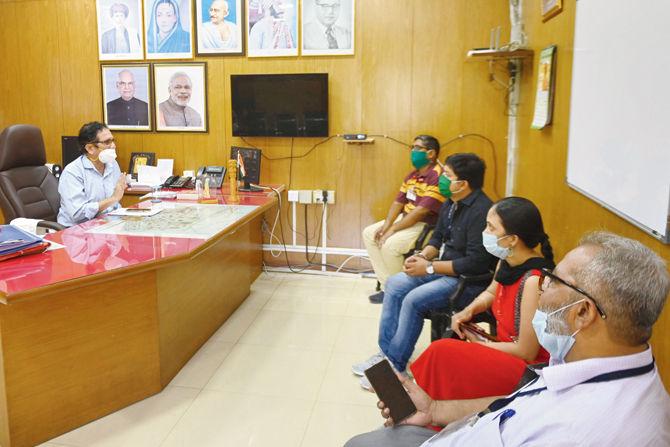
Nitin Arte, assistant municipal comissioner of B ward, holds a meeting with Dr Sandeep Gaikwad, medical health officer at E ward, and Dr Sharada Bhagat, assistant medical officer, at the municipal office in Umerkhadi
Evidently, the process is laborious and manpower-driven. "The first step is to call up the index patient who has been diagnosed with the virus and confirm their place of residence. This is followed by taking down a detailed history of where they have travelled, eaten, slept, and bathed, number of members in the family, whether they have a toilet at home or use a common one, who did they have contact with 48 hours prior to their positive test and so on. Our contact tracers then follow up with all the contacts named, who are then quarantined," he says. Data is also collected on the number of residents in the building where a positive is reported, before sealing it. A crucial part of their job is to track down every single person who has recently come in contact with the known case—those who haven't been tested, but may have the potential to spread the virus.
"Not all patients are able to rattle off names [of contacts] when asked," says Dr Siddhi Koli from B Ward, who leads a team of health workers. They have to work backwards, gently prod patients to recall locations and names of family, colleagues, and others who they encountered in the hours before symptoms appeared. "It's part therapist-part detective work," she says. On an average, around five high-risk contacts are found and quarantined. And no two cases are alike. Some are forthcoming and willing to cooperate, others are either fearful or in denial. The disclosures are voluntary, as is the cooperation of those named. "I remember a case, where the patient refused to volunteer information. He said, 'No, we were all at home and did not step out.' We were forced to take swab tests of the entire family. When all members tested positive, they panicked and spilled the beans that a bunch of relatives from Afghanistan had visited them."
Dr Patil says it's common for patients to be reluctant about offering information over the phone. Getting to the truth requires patience and understanding. "We have come across cases where neighbours have threatened patients to keep mum and not reveal that they were in touch."
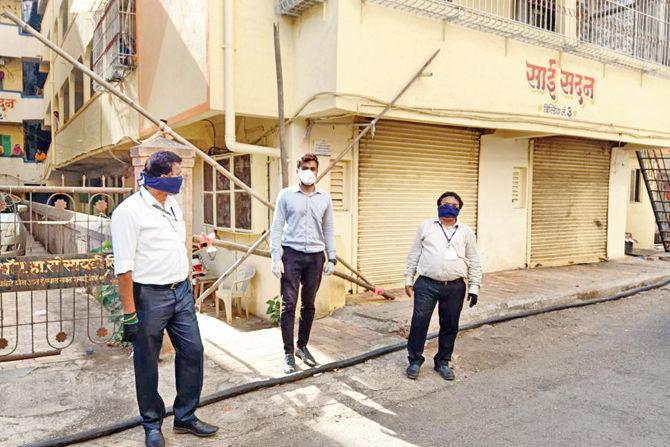
Officials from the Kalyan-Dombivli Municipal Corporation (KDMC) health department during a community visit
Contacts are encouraged to stay home and maintain social distance from others (at least 6 feet) until 14 days after their last exposure, in case they also become ill. Under duress, the team has even sought help from bouncers to tackle aggressive residents. Patil says they work with the tacit understanding that a positive patient would have come across 10 people, if not more. "Numbers are rising because people aren't taking the lockdown seriously, and I'm not even referring to those in slum pockets. Even the affluent are using grocery shopping as an excuse to step out," he says.
The ability to elicit relevant information from patients also hinges on the interviewer's skills. Koli says the key is to use the right tone; the approach must be polite and friendly, but assertive. "That's the reason we prefer CHVs in our midst. They are resourceful, share a rapport with locals and possess people skills." Koli has often come across cases, where rich families masquerade their maids and helpers as family members. "Many families aren't paying their help, so they are forced to show up at work due to desperation. It's particularly difficult to keep track of movements in standalone buildings with no security guard."
If tracing within the city is a challenge, the problem is exacerbated on an inter-district level. Earlier this month, the Kalyan-Dombivli Municipal Corporation (KDMC), Ulhasnagar Municipal Corporation (UMC) and Navi Mumbai Municipal Corporation (NMMC) issued an order restricting the movement of people working in essential services in Mumbai but residing in these areas. The decision was taken in view of the rising number of Coronavirus cases in Mumbai. The announcement led to outrage given that close to 25,000 essential service workers travel from the limits of KDMC, UMC and NMMC to Mumbai each day. "It couldn't be implemented because if we restrict workers from travelling to the city, the government departments won't be able to function as most of the workers live in Mumbai's outskirts," says Akshay Gudade, assistant commissioner, KDMC. Of the 30 COVID-19 positive cases they receive daily, the infection of 20 patients is traced to Mumbai. "Because inter-district tracing is difficult due to protocol and coordination issues, we inform the respective wards, where the patient works, about the case."
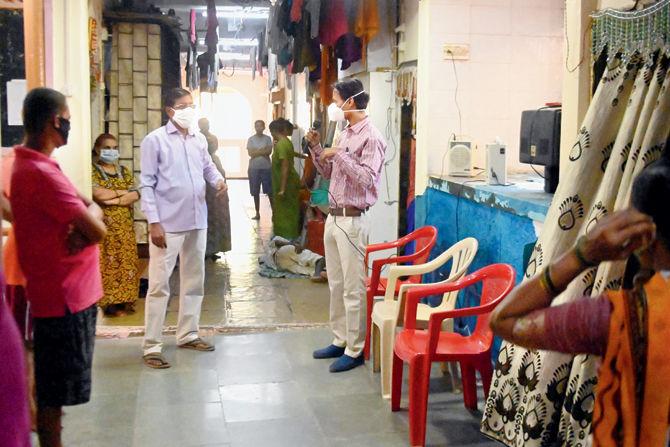
Dr Anupam Borade, assistant medical officer of E ward at Tadwadi health post, Mazagaon
That said, each area throws up its own challenges. The E ward, comprising Byculla, Nagpada, and parts of Agripada, has been under duress given the presence of five large hospitals—JJ, Nair, Prince Ali Khan, Wockhardt and Saboo Siddique—each reporting infections among its employees. Dr Sandeep Gaikwad, medical officer of health, says a severe staff crunch has made matters worse. "A lot of community health workers don't want to take the risk of contact tracing for a measly R9,000 stipend a month. I understand their sentiment, because there's no end to the amount of work they have to take on. We receive four new lists of patients in a day. By the time you finish one, the next one is waiting. It's exhausting." Several of his staffers are sleep-deprived and haven't gone home in 40 days. Gaikwad says the overriding fear is the risk of infecting family members. "My daughter waits up for me even if it's 3 am. Naturally, they are worried." Dolkar says right before she is to hit home, she calls her husband to hold onto their daughter so that she doesn't come unannounced and hug her. "I rush straight to the bathroom," she says. Koli, a mother of two, is cautious about sanitising her clothes and medical equipment. She has a separate box to store her material. The job also takes an emotional toll. "I might keep a brave face, but inside, I'm afraid. Every day, I go home with the fear that I might infect my family."
Despite the challenges, experts say contact tracing is the only way ahead. Giridhara Babu, professor and head, lifecourse epidemiology, Indian Institute of Public Health, explains that contact tracing has been traditionally used to slow down the spread of diseases such as tuberculosis and HIV. West African countries used it to contain the Ebola outbreak in 2014, and Asian countries, including China, used the method to contain the SARS outbreak in 2003. Contact tracing is a time-tested public health strategy that is standard with infectious diseases. According to him, contact tracing is the reason why a few Indian states have done well in containing the disease as compared to others. "For instance, Bengaluru and Kerala swung into action in the initial phase of the outbreak. They went back and made a list of all the people that international passengers had met in the last one month. They may not have been able to trace all, but a large number of them were identified."
A key part of the discussion is the role of technology. Tech giants Apple and Google have been working on a contact tracing tool since April. The state government of Maharashtra also announced the launch of MahaKavach, a smartphone app that will help officials track suspected COVID-19 cases in the state. The app will only be used by the government to track specific, suspected COVID-19 cases, or those who have already been put in quarantine. It will use smartphone-based location services to geo-fence individuals. "We aren't claiming to replace the role that humans can play in contact tracing. It can only supplement their efforts," says Amit Kothawade, assistant manager, start-up and innovation, at Maharashtra State Innovation Society. Babu, too, claims that while tracers are human, and can miss information, their role is irreplaceable. It's this thought that gives volunteers like Dolkar a sense of purpose. She says, "I will have a peaceful night's sleep only once the pandemic ends."
Expert speak

Giridhara Babu
professor of epidemiology with the Public Health Foundation of India
Contact tracing is a time-tested public health strategy that is standard with infectious diseases. Bengaluru and Kerala swung into action in the initial phase of the outbreak.
They went back and made a list of all the people that international passengers had met in the last one month. They may not have been able to trace all, but a large number of them were identified
Catch up on all the latest Mumbai news, crime news, current affairs, and a complete guide from food to things to do and events across Mumbai. Also download the new mid-day Android and iOS apps to get latest updates.
Mid-Day is now on Telegram. Click here to join our channel (@middayinfomedialtd) and stay updated with the latest news
 Subscribe today by clicking the link and stay updated with the latest news!" Click here!
Subscribe today by clicking the link and stay updated with the latest news!" Click here!








